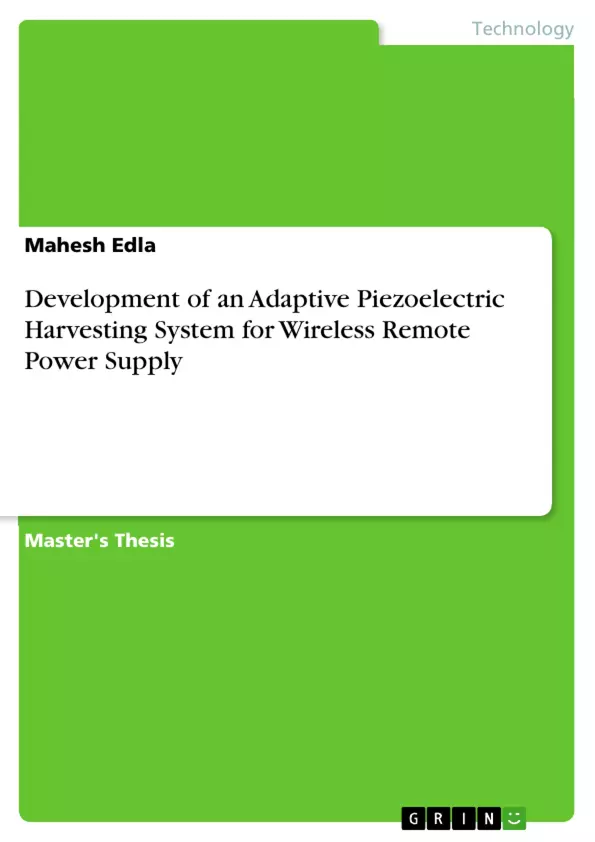Increasing energy consumption in modern electronic systems has allowed energy harvesting materials to grow at a rapid pace. Environmental energy harvesting, in particular vibration based, have developed as a viable technique to supplement battery supplies.
This project develops a sustained operation to power an electric system. Piezoelectric materials allow to convert mechanical energy into electrical energy. This can be done through solar, vibrations, heat, strain, etc. The energy can also be stored for later use. It is also varying the voltage and adjust the amplitude piezoelectric harvesting components and storage devices (such as batteries, super capacitors, etc.).
In this project, a low cost, reliable, environmentally friendly and portable solution is developed by using the piezoelectric method. Piezoelectric materials have many applications in real life, such as generating electrical energy from moving objects, trains, bicycles, etc. This technology is used in many applications , like monitoring, robotics, military.
Objectives of this paper are: to understand the how piezoelectric system works; to analyse the piezoelectric design of system & using device data sheets where necessary; to understand the real life applications; to understand the behaviour of the piezoelectric system on load; and to compare the results.
Inhaltsverzeichnis (Table of Contents)
- Abstract
- Acknowledgement
- 1 Introduction
- 1. a Background of the project
- 1. b context and background
- 1. c importance
- 1. d example method to overcome problems
- 1.1 project objectives
- 1.2 overview of the project
- 1.2. a utilization of the direct piezoelectric effect
- 1.2. b application oriented solutions
- 1.2. c data monitoring
- 1.2. d product monitoring
- 1.3 outlining of energy harvesting
- 2 Power harvesting theory
- 3 literature review
- 3.1. a solar
- 3.1. b fluid flow
- 3.1. c temperature difference
- 3.1.d radio frequency
- 3.2 vibration
- 3.3 energy harvesting methods
- 3.3.a electromagnetic transduction
- 3.3.b electrostatic transduction
- 3.3.c piezoelectric transduction
- 3.4 vibration transduction
- 3.4.a vibration sources
- 3.4.b importance of resonant frequency and mass
- 3.4.c push for MEMS energy harvesting
- 3.5 transduction mechanism
- 3.5.a piezoelectric generator
- 3.5.b electro generator
- 3.5.c electromagnetic generator
- 3.6 piezoelectric harvesting system
- 3.6.a fundamental concept
- 3.6.b appendixes
- 3.6.c semiconductor components
- 3.6.d diodes and rectifiers
- 3.7 direct current impedance matching
- 3.7.a direct current impedance matching
- 3.7.b DCIM circuit design and operation
- 3.8 synchronous electric charge extraction circuit
- 3.8.a circuit design and operation
- 3.8.b max harvested power
- 3.8.c brief advantages
- 3.9 electrical circuits
- 3.9.a depending on excitation frequency
- 3.9.b power storage and circuitry
- 3.9.c storage device
- 3.9.d charge/discharge efficiency
- 3.9.1 Model equivalent circuit
- 3.9.1.a internal series resistance
- 3.9.1.b leakage resistance
- 3.9.1.c power loss efficiency
- 3.9.2 Experimental validation
- 4 design of the circuit
- 4.a piezoelectric element
- 4.b capacitor
- 4.c ac-dc rectifier circuit
- 4.1 dc-dc step up converter
- 4.1.a features
- 4.1.b pin description
- 4.2 project design
- 4.3 experimental procedure
- 5 implementation
- 5.1 testing and results
- 6 project management
- 6.1 project schedule
- 6.2 risk management
- 6.3 quality management
- 7 circuit appraisal
Zielsetzung und Themenschwerpunkte (Objectives and Key Themes)
This project aims to develop a low-cost, reliable, environmentally friendly, and portable solution for powering electronic systems using piezoelectric energy harvesting. This solution utilizes piezoelectric materials to convert mechanical energy, such as vibrations, into electrical energy, which can then be stored and used to power various devices. The project focuses on optimizing energy conversion efficiency through a combination of hardware design and adaptive control methods.
- Efficient energy harvesting from ambient vibrations
- Adaptive control methods for maximizing power conversion efficiency
- Sustainable and environmentally friendly power supply solutions
- Applications in wireless sensor networks and other low-power devices
- Development of a portable and cost-effective energy harvesting system
Zusammenfassung der Kapitel (Chapter Summaries)
The project begins with an introduction to the concept of piezoelectric energy harvesting and its potential applications. Chapter 1 outlines the project's background, objectives, and the importance of sustainable energy solutions. Chapter 2 explores the theory behind power harvesting, focusing on different methods and their respective advantages and disadvantages. Chapter 3 delves into the literature review, exploring various energy harvesting techniques, specifically focusing on vibration-based energy harvesting and piezoelectric transduction. This chapter also examines the design and operation of different circuits, including DC-DC converters, and the importance of impedance matching.
Chapter 4 focuses on the design and implementation of the proposed energy harvesting circuit, outlining the selection of components, circuit design, and the experimental procedure. Chapter 5 presents the implementation of the system, discussing the testing and results obtained. Chapter 6 covers the project management aspects, including scheduling, risk management, and quality control. Finally, Chapter 7 provides an appraisal of the designed circuit, highlighting its performance and potential for future improvement.
Schlüsselwörter (Keywords)
The key terms and concepts of this project include piezoelectric energy harvesting, vibration-based energy harvesting, adaptive control, DC-DC converters, impedance matching, energy conversion efficiency, wireless sensor networks, sustainable power supply, low-power devices, and portable energy harvesting systems.
- Quote paper
- Mahesh Edla (Author), 2015, Development of an Adaptive Piezoelectric Harvesting System for Wireless Remote Power Supply, Munich, GRIN Verlag, https://www.hausarbeiten.de/document/377985


